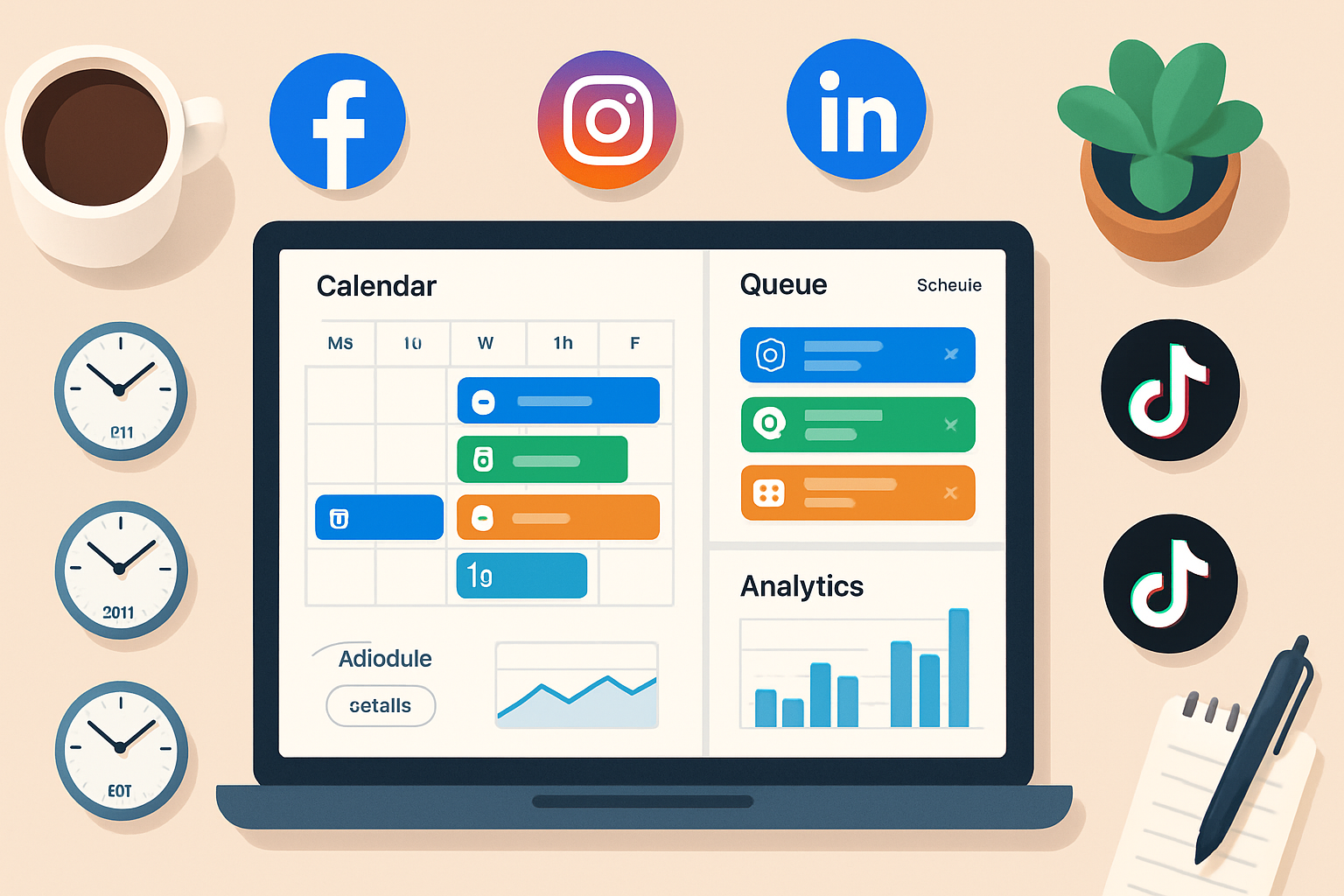· business · 6 min read
Mastering the Art of Timing: Buffer's Best Practices for Scheduling Posts
A practical guide to scheduling social media posts with Buffer: how to use analytics, run timing experiments, segment audiences, and align posting cadence with seasonal trends to maximize engagement.

Why timing matters (beyond ‘post when they’re online’)
Timing isn’t just about waking up at 9 a.m. and hitting publish. It’s a strategic lever that affects who sees your content, how quickly they engage, and whether that engagement turns into reach and conversions. Algorithms reward early engagement; posting at the right moment increases the chance your post will be picked up and shown to a wider audience. But “right moment” depends on audience behavior, platform norms, and even seasonality.
Below I walk through a practical, test-driven approach to timing using Buffer’s scheduling tools and analytics, plus advanced techniques you can apply across platforms.
1) Start with data: Let analytics guide, not dictate
Use Buffer Analyze and account-level analytics to identify when your posts historically get the most impressions, clicks, and engagement. Buffer’s insights and suggested posting times are a good starting point. See Buffer’s article on best times to post for additional context: https://buffer.com/library/best-time-to-post-social-media
Cross-check with platform analytics (Facebook Insights, Instagram Insights, LinkedIn Analytics, X/Twitter Analytics) to validate patterns found in Buffer.
Supplement with third-party benchmarks (e.g., Sprout Social, Hootsuite) to understand broader industry norms, but treat these as directional rather than prescriptive: https://sproutsocial.com/insights/best-times-to-post-on-social-media/ and https://hootsuite.com/resources/best-time-to-post-on-social-media
Key metrics to extract per time slot/day:
- Engagement rate (likes, comments, shares per impression)
- Click-through rate (for traffic-focused posts)
- Reach/impressions
- Conversions (if you’re tracking via UTM/GTM)
Tip: Tag posts with campaign UTMs and review traffic & conversions in Google Analytics to connect posting time to downstream results (see Google’s UTM guide): https://support.google.com/analytics/answer/1033863
2) Build an experiment plan (A/B test timing like you would creative)
If you only test once, you’ll mistake noise for signal. Run controlled timing experiments:
- Define the hypothesis - “Posting between 11 a.m.–1 p.m. on weekdays will get 20% more clicks than posting between 7–9 p.m.”
- Choose variables - day of week and hour (keep post content and format constant). Use Buffer’s queue and custom schedules to place identical posts in different time slots.
- Test length - run each test for at least 2–4 weeks, depending on follower size. Small audiences need longer to gather sample size.
- Track results across the key metrics and use rolling averages to smooth daily volatility.
Experiment tips:
- Only change one dimension at a time (day or hour) to isolate effects.
- Run tests across multiple content types (link posts, images, short videos) - different formats often have different engagement windows.
- If your audience is international, test time-zone segmentation (see section 4).
3) Use Buffer features to operationalize timing
- Suggested times / optimal timing - Buffer can surface suggested posting times based on your historical engagement. Use these as starting points but validate with experiments.
- Custom schedules and queues - create separate weekly schedules per profile (e.g., one for LinkedIn, another for Instagram). This ensures each platform uses the cadence that works best for it.
- Buffer’s queue shuffling and Buffer Publish let you manage recurring content and fill gaps without manual work.
Reference: Buffer’s scheduling guides and product pages explain how to configure schedules and use analytics: https://buffer.com/library/scheduling-posts
4) Segment by audience and time zone
For brands with global audiences, timing must consider geography:
- Segment accounts by primary audience regions and create posting schedules for each. In Buffer you can create multiple posting schedules tailored to the predominant time zones of each audience.
- Consider duplicating high-priority content and scheduling it to appear in each target region’s local peak hours (don’t repost too frequently to avoid fatigue).
Example: If 40% of your followers are in London and 30% in New York, schedule a first post at 9 a.m. GMT and a second at 9 a.m. ET for maximal local visibility.
5) Content buckets + cadence: match message to moment
Different types of posts perform better at different times. Organize content into buckets and map preferred posting windows:
- Quick wins (news, promotions) - post during high-traffic windows when people scroll fast - early morning commutes, lunch, early evening.
- Thought leadership / long-form - post mid-morning or mid-afternoon when audiences have time to read and engage.
- B2B targeting working professionals - weekdays during business hours; avoid late nights and weekends.
- B2C lifestyle content - evenings and weekends can outperform weekdays.
Create a simple matrix in Buffer assigning each bucket to 2–3 candidate time slots to feed the queue.
6) Account for seasonality and events
Seasonality changes behavior - holidays, school cycles, product launches, or industry events reshape peak engagement:
- Maintain a seasonal calendar and annotate expected changes (e.g., holiday shopping spikes, summer slowdowns).
- Increase posting frequency around events and use Buffer’s scheduled campaigns to queue supporting posts.
- Track performance during prior seasons and use that historical benchmark when planning.
Practical approach: run a “seasonal pulse” review monthly and adjust suggested times in Buffer accordingly.
7) Evergreen content and recycling smartly
Evergreen posts can be re-shared, but timing matters to avoid audience fatigue:
- Stagger recirculation across different days and times to reach different segments.
- When resharing, retarget different follower clusters (e.g., different time zones or interest groups).
- Use A/B tests to determine whether evergreen content performs better in morning or evening slots.
Buffer supports queuing and recycling - but set sensible intervals between reposts and label posts clearly so you can track performance by iteration.
8) Advanced analysis: statistical confidence and meaningful lifts
- Use rolling means and median engagement to avoid being misled by outliers.
- Look at relative lift, not just absolute numbers. A 15% lift in engagement might be meaningful for mature accounts; for small accounts it could be noise.
- Aim for statistical confidence when possible. If you can, calculate whether observed differences are unlikely to be due to chance. For many social experiments, a practical rule is - larger samples (hundreds to thousands of impressions) produce more reliable conclusions.
If you’re not running strict statistical tests, use these heuristics:
- Wait for a minimum sample (e.g., 200–500 impressions per time slot) before acting.
- Prefer consistent multi-week trends over single-day spikes.
9) Platform-specific timing notes
- Instagram - engagement often spikes around midday and evenings; Stories have different consumption habits than feed posts.
- Facebook - mid-afternoon on weekdays can work well; video may do better in early evening.
- LinkedIn - weekdays during business hours, with peak interaction early mid-morning.
- X/Twitter - real-time platform - more frequent posting and experimentation across hourly slots is common.
Always validate with your own audience - generalized rules are only a starting point. For aggregated platform research, see Sprout Social or Hootsuite references above.
10) Operational checklist to implement in Buffer (copy/paste)
- Audit last 90 days of analytics in Buffer and native platform insights.
- Define 3 candidate daily schedules based on data (e.g., morning, midday, evening).
- Create a 4-week A/B timing test plan using Buffer’s queue/scheduling features.
- Tag all test posts with UTMs and label in your content calendar.
- Collect results weekly; compute rolling averages and impression baselines.
- Identify winning time slots by engagement lift and confidence; update Buffer’s custom schedule.
- Repeat tests quarterly and whenever major audience or seasonal shifts occur.
Final thoughts: make timing a system, not a superstition
Effective timing is repeatable and measurable. Use Buffer’s scheduling and analytics as your operational engine, but pair it with disciplined experiments, season-aware planning, and platform-specific adjustments. Over time you’ll replace guesswork with a dynamic posting schedule that adapts to audience behavior, market rhythms, and your content strategy.
For more on Buffer’s scheduling features and analytics, see Buffer’s help library: https://buffer.com/library/scheduling-posts
References:
- Buffer - The Best Time to Post on Social Media: https://buffer.com/library/best-time-to-post-social-media
- Sprout Social - Best Times to Post on Social Media: https://sproutsocial.com/insights/best-times-to-post-on-social-media/
- Hootsuite - Best Time to Post on Social Media: https://hootsuite.com/resources/best-time-to-post-on-social-media
- Google Analytics - Use campaign parameters (UTM): https://support.google.com/analytics/answer/1033863



